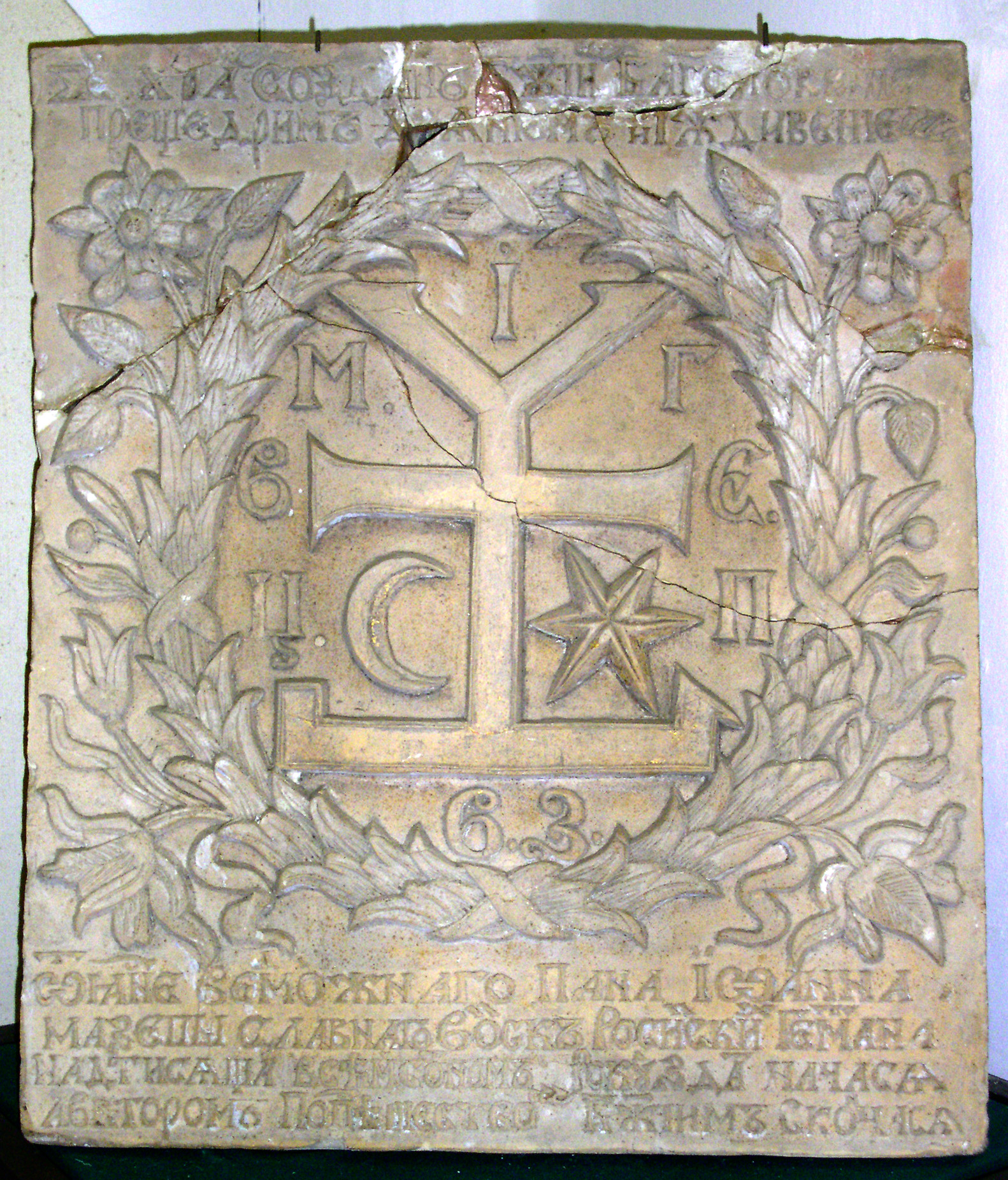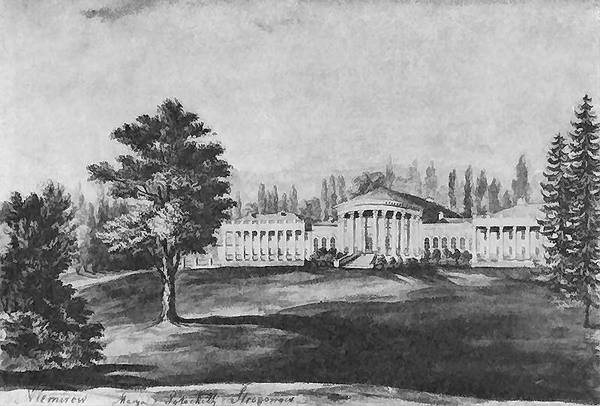|
Semen Paliy
Semen Paliy ( uk, Семен Палiй, pl, Semen Palej) (c. 1645 – 1710) was a Ukrainian Cossack polkovnyk (colonel). Born in Chernihiv region, Paliy settled in Zaporizhian Sich at a very young age and gained fame as a brave fighter and Zaporozhian Cossack. In 1685 Paliy moved to Right-bank Ukraine and joined the service of Polish–Lithuanian Commonwealth king Jan Sobieski. During his years in Polish service, Paliy proved himself as an able Cossack commander in wars against Crimean Tatars and Ottoman Turks. Among other military deeds his men successfully raided the Turkish fortress of Ochakov and participated in the Battle of Vienna. He became the ataman of Right-bank Ukraine, still under Polish control (where the left-bank was under Russian control). In the 1690s Semen Paliy, however, became wary of Polish overlordship of Ukraine and sent several requests to Moscow asking the Russians to help him free right-bank Ukraine from Poland. In 1699 a new Polish king Augustus ... [...More Info...] [...Related Items...] OR: [Wikipedia] [Google] [Baidu] |
Augustus II Of Poland
Augustus II; german: August der Starke; lt, Augustas II; in Saxony also known as Frederick Augustus I – Friedrich August I (12 May 16701 February 1733), most commonly known as Augustus the Strong, was Elector of Saxony from 1694 as well as King of Poland and Grand Duke of Lithuania in the years 1697–1706 and from 1709 until his death in 1733. He belonged to the Albertine line of the House of Wettin. Augustus' great physical strength earned him the nicknames "the Strong", "the Saxon Hercules" and "Iron-Hand". He liked to show that he lived up to his name by breaking horseshoes with his bare hands and engaging in fox tossing by holding the end of his sling with just one finger while two of the strongest men in his court held the other end.Sacheverell Sitwell. ''The Hunters and the Hunted'', p. 60. Macmillan, 1947. He is also notable for fathering a very large number of children. In order to be elected King of the Polish–Lithuanian Commonwealth, Augustus converted to Roman ... [...More Info...] [...Related Items...] OR: [Wikipedia] [Google] [Baidu] |
Sweden
Sweden, ; fi, Ruotsi; fit, Ruotti; se, Ruoŧŧa; smj, Svierik; sje, Sverji; sju, Sverje; sma, Sveerje or ; yi, שוועדן, Shvedn; rmu, Svedikko; rmf, Sveittiko. formally the Kingdom of Sweden, is a Nordic countries, Nordic country located on the Scandinavian Peninsula in Northern Europe. It borders Norway to the west and north, and Finland to the east. At , Sweden is the largest Nordic country and the List of European countries by area, fifth-largest country in Europe. The Capital city, capital and largest city is Stockholm. Sweden has a population of 10.5 million, and a low population density of ; around 87% of Swedes reside in urban areas in the central and southern half of the country. Sweden’s urban areas together cover 1.5% of its land area. Because the country is so long, ranging from 55th parallel north, 55°N to 69th parallel north, 69°N, the climate of Sweden is diverse. Sweden has been inhabited since Prehistoric Sweden, prehistoric times, . T ... [...More Info...] [...Related Items...] OR: [Wikipedia] [Google] [Baidu] |
Ivan Mazepa
Ivan Stepanovych Mazepa (also spelled Mazeppa; uk, Іван Степанович Мазепа, pl, Jan Mazepa Kołodyński; ) was a Ukrainian military, political, and civic leader who served as the Hetman of Zaporizhian Host in 1687–1708. He was awarded a title of Prince of the Holy Roman Empire in 1707 for his efforts for the Holy League. The historical events of Mazepa's life have inspired many literary, artistic and musical works. He was famous as a patron of the arts. Mazepa played an important role in the Battle of Poltava (1709), where after learning that Tsar Peter I intended to relieve him as acting Hetman (military leader) of Zaporozhian Host (a Cossack state) and to replace him with Alexander Menshikov, he defected from his army and sided with King Charles XII of Sweden. The political consequences and interpretation of this defection have resonated in the national histories both of Russia and of Ukraine. The Russian Orthodox Church laid an anathema (exc ... [...More Info...] [...Related Items...] OR: [Wikipedia] [Google] [Baidu] |
Left-bank Ukraine
Left-bank Ukraine ( uk, Лівобережна Україна, translit=Livoberezhna Ukrayina; russian: Левобережная Украина, translit=Levoberezhnaya Ukraina; pl, Lewobrzeżna Ukraina) is a historic name of the part of Ukraine on the left (east) bank of the Dnieper River, comprising the modern-day oblasts of Chernihiv, Poltava and Sumy as well as the eastern parts of Kyiv and Cherkasy. History The term appeared in 1663 with the election of Ivan Bryukhovetsky as the hetman of Ukraine in opposition to Pavlo Teteria. Bryukhovetsky was the first known "left-bank Ukraine" hetman over the area that was under the Russian influence. Up until the mid-17th century, the area had belonged to the Polish–Lithuanian Commonwealth. The Treaty of Pereyaslav of 1654 saw the region tentatively come under Russian control, when local Cossack leaders swore allegiance to the Russian monarchy in exchange for military protection. Russian sovereignty over the area was later re ... [...More Info...] [...Related Items...] OR: [Wikipedia] [Google] [Baidu] |
Peter I Of Russia
Peter I ( – ), most commonly known as Peter the Great,) or Pyotr Alekséyevich ( rus, Пётр Алексе́евич, p=ˈpʲɵtr ɐlʲɪˈksʲejɪvʲɪtɕ, , group=pron was a List of Russian monarchs, Russian monarch who ruled the Tsardom of Russia from to 1721 and subsequently the Russian Empire until his death in 1725, coregency, jointly ruling with his elder half-brother, Ivan V of Russia, Ivan V until 1696. He is primarily credited with the modernisation of the country, transforming it into a European power. Through a number of successful wars, he captured ports at Azov and the Baltic Sea, laying the groundwork for the Imperial Russian Navy, ending uncontested Swedish Empire, Swedish supremacy in the Baltic and beginning the Tsardom's expansion into a much larger empire that became a major European power. He led a cultural revolution that replaced some of the traditionalist and medieval social and political systems with ones that were modern, scientific, Weste ... [...More Info...] [...Related Items...] OR: [Wikipedia] [Google] [Baidu] |
Berdychiv
Berdychiv ( uk, Берди́чів, ; pl, Berdyczów; yi, באַרדיטשעװ, Barditshev; russian: Берди́чев, Berdichev) is a historic city in the Zhytomyr Oblast (province) of northern Ukraine. Serving as the administrative center of the Berdychiv Raion (district), the city itself is of direct oblast subordinance, and does not belong to the district. It is south of the oblast capital, Zhytomyr. Its population is approximately . History The territory on which the city is located was inhabited as early as the 2nd millennium BC. Bronze Age settlements and the remains of two settlements of the Chernyakhov culture were discovered here. In 1430, Grand Duke of Lithuania Vytautas (великий князь литовський Вітовт) granted the rights over the area to Kalinik, the procurator (намісник) of Putyvl and Zvenigorod, and it is believed that his servant named Berdich founded a '' khutor'' (remote settlement) there. However the etymology of ... [...More Info...] [...Related Items...] OR: [Wikipedia] [Google] [Baidu] |
Szlachta
The ''szlachta'' (Polish: endonym, Lithuanian: šlėkta) were the noble estate of the realm in the Kingdom of Poland, the Grand Duchy of Lithuania, and the Polish–Lithuanian Commonwealth who, as a class, had the dominating position in the state, exercising extensive political rights and power. Szlachta as a class differed significantly from the feudal nobility of Western Europe. The estate was officially abolished in 1921 by the March Constitution."Szlachta. Szlachta w Polsce" ''Encyklopedia PWN'' The origins of the ''szlachta'' are obscure and the subject of several theories. Traditionally, its members owned land (allods), [...More Info...] [...Related Items...] OR: [Wikipedia] [Google] [Baidu] |
Nemirov
Nemyriv ( uk, Немирів, russian: Немирoв, pl, Niemirów) is a historic town in Vinnytsia Oblast (province) in Ukraine, located in the historical region of Podolia. It was the administrative center of former Nemyriv Raion (district). Population: Nemyriv is one of the oldest cities in Vinnytska oblast, Ukraine. It was founded by Prince Nemyr in 1390. It is a minor industrial center. The distiller company that produces Ukrainian Nemiroff (Russian spelling) vodka is located in Nemyriv. The town's tourist attractions include a late 19th-century palace (which belonged to the House of Potocki) and a park complex. History Nemyriv was built on the site of ancient Scythian settlement Myriv, destroyed during the Mongol invasion of Rus'. It was first mentioned under its modern name in 1506, which ultimately derives from the Slavic given name Niemir. It was a private town of Poland, owned by the families of Zbaraski and Potocki. Polish King Stanisław August Poniatowsk ... [...More Info...] [...Related Items...] OR: [Wikipedia] [Google] [Baidu] |
Fastiv
Fastiv ( uk, Фа́стів) is a city in the Kyiv Oblast (province) in central Ukraine. On older maps it is depicted as Chvastiv ( pl, Chwastów). Administratively, it is incorporated as a city of oblast significance. It also serves as the administrative center of the Fastiv Raion (district), to which it does not administratively belong. Fastiv hosts the administration of Fastiv urban hromada, one of the hromadas of Ukraine. Its population is approximately . Lying on conjunction of railway lines, Fastiv is an important node station on the rail route from central Europe to Russia and Asia. On 1 December 1918 at the Fastiv train station delegations of the Ukrainian People's Republic and the West Ukrainian People's Republic signed the Unification Act uniting territories of Ukraine that were split between Austrian and Russian empires. Beside transportation industry, Brewing and machinery industry are also present, although the majority of inhabitants are employed by Ukrzaliznytsi ... [...More Info...] [...Related Items...] OR: [Wikipedia] [Google] [Baidu] |
Bila Tserkva
Bila Tserkva ( uk, Бі́ла Це́рква ; ) is a city in the center of Ukraine, the largest city in Kyiv Oblast (after Kyiv, which is the administrative center, but not part of the oblast), and part of the Right Bank. It serves as the administrative center of Bila Tserkva Raion and hosts the administration of Bila Tserkva urban hromada, one of the hromadas of Ukraine. Bila Tserkva is located on the Ros River approximately south of Kyiv. The city has an area of . Its population is approximately The ancient city of Bila Tserkva was founded in 1032 to provide important defenses against nomadic tribes. In the 13th century, it was invaded by the Mongols, however, and the city was devastated.Kohut, Zenon E. "Mazepa's Ukraine: Understanding Cossack Territorial Vistas." ''Harvard Ukrainian Studies'' 31, no. 1/4 (2009): 1–28 In 1651, it was the site of an important battle between the warring Zaporozhian Host, Zaporozhian Cossack Army (and their Tatar allies) and the Polis ... [...More Info...] [...Related Items...] OR: [Wikipedia] [Google] [Baidu] |
Cossack Uprisings
The Cossack uprisings (also kozak rebellions, revolts) were a series of military conflicts between the cossacks and the states claiming dominion over the territories the Cossacks lived in, namely the Polish–Lithuanian Commonwealth and Russian Empire during the 16th, 17th, and 18th centuries. Both states tried to exert control over the independent-minded Cossacks. While the early uprisings were against the Commonwealth, as the Russian Empire gained increasing and then total control over the Ruthenian (Ukrainian) lands where the Cossacks lived, the target of Cossacks uprisings changed as well. The origins of the first Cossacks are disputed. Traditional historiography dates the emergence of Cossacks to the 14th to 15th centuries. Towards the end of the 15th century, the Ukrainian Cossacks formed the Zaporozhian Sich centered on the fortified Dnipro islands. Initially a vassal of Polish–Lithuanian Commonwealth, the increasing social and religious pressure from the Commonwealth c ... [...More Info...] [...Related Items...] OR: [Wikipedia] [Google] [Baidu] |
.jpg)



